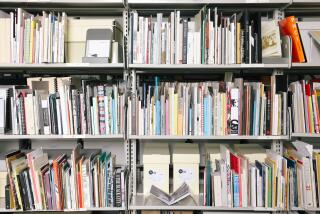Lasers May Hold Key to Rare Recordings
- Share via
SYRACUSE, N.Y. — For seven years, Syracuse University researchers have had a mystery they dared not solve: a rare 19th-century wax cylinder recording that can’t be played without being damaged.
Now, however, a new playback system being developed at the university’s Belfer Audio Laboratory and Archive may reveal whether the cylinder contains what researchers believe it does: an 1895 recording of opera legend Adelina Patti.
The brown cylinder, which the university received in 1993, is so delicate that all playback systems now available could spoil it with the friction they produce. The frictionless Syracuse system, by contrast, will use weak laser beams that won’t deform or degrade cylinders.
If successful, the system will allow researchers to play and preserve some of history’s oldest surviving sound recordings without destroying or damaging them in the process.
“Necessity is the mother of invention,” said Susan Stinson, the archive’s curator and project coordinator. “The idea is to have something that isn’t going to wear away the recordings as we listen to them. It’s easier said than done.”
Patti, who died in 1919, was considered the greatest coloratura soprano of the 19th century. The only known recordings of her are some 78 rpm discs made by the English Gramophone Co. in Patti’s Welsh castle.
Those were recorded in 1905 and 1906, when the singer was in her 60s and past her prime. Stinson believes the wax cylinder is a homemade recording of Patti 10 years earlier, when she was still in full command of her voice.
“We really have no idea what’s on it,” Stinson said. “We are saving it. When the machine is ready, it will be the great unveiling. It would be a monumental find.”
Among its audio collection, Belfer holds 22,000 cylinders, the largest collection of commercial and noncommercial cylinders outside the Library of Congress. With more than 300,000 recordings of all kinds, Belfer is the nation’s second largest university sound archive behind Bowling Green.
“Laser technology as it applies to cylinders has great promise,” said George Kipper, a Library of Congress expert on cylinder recordings and an extensive collector himself.
“Every decade that we procrastinate, that we don’t actually start a mass process of transferring these sounds, . . . we lose more of the sounds,” Kipper said.
Among other rarities in the Belfer collection are two of only three cylinders recorded by tenor Enrico Caruso and a 1903 cylinder of Pope Leo XIII made in the Vatican.
Cylinder recordings were first made in the 1880s and were popular only for a short time around the turn of the century. Thomas Edison liked the cylinders and continued making them into the late 1920s, but most companies switched to discs, which were less bulky and could hold more music because they could be recorded on both sides, Stinson said.
“These recordings give us an aural picture of our culture and society a century ago--a society in flux with millions of new[ly] arrived immigrants from throughout the world and a plethora of life-changing inventions,” Stinson said.
Early cylinder recordings provide a faithful reflection of culture at the turn of the century, she said, from vaudeville routines to the speeches of Theodore Roosevelt, William Howard Taft and William Jennings Bryan.
Relatively few cylinders have survived in playable condition, and many of those have grown exceedingly fragile, limiting how much they can be used for research.
Until now, researchers have used playback systems that use a jewel-tipped stylus and produce friction on the cylinder.
The Library of Congress has used a vertical-tracking stylus to transfer the sound on its cylinders to a digital format, which makes it possible to clean recordings of pops, ticks and scratches and reproduce them on compact disks or cassettes for commercial sale. But even that method wears on the cylinders and does not allow for repeated playbacks, which often are necessary to get full replication, Kipper said.
“Repeated playback with any type of stylus produces minute shavings,” he said. “It’s not advantageous for an archive to start shaving away their recordings.”
A laser-based system, more easily adjustable than one using a stylus, also would be able to play cylinders produced at a variety of speeds and volumes, Kipper said.
Syracuse University researchers began looking into the problem more than a decade ago but were hindered by a lack of money and time. Several years ago, faculty and students at the university’s engineering college came up with a system using a laser beam.
Dr. William A. Penn, an adjunct professor of electrical engineering and computer science, is directing the design and construction of the laser playback system prototype.
Syracuse recently received a $158,000 grant to pay for materials and consultants and allow Penn to devote himself full-time to the project, Stinson said.
It may be just in time. The effort to preserve and duplicate the wax cylinders is a race against the ravages of mold, mildew, aging and disintegration.
“They are sort of like living time bombs,” Kipper said. “They need immediate attention.”
More to Read
Sign up for Essential California
The most important California stories and recommendations in your inbox every morning.
You may occasionally receive promotional content from the Los Angeles Times.












